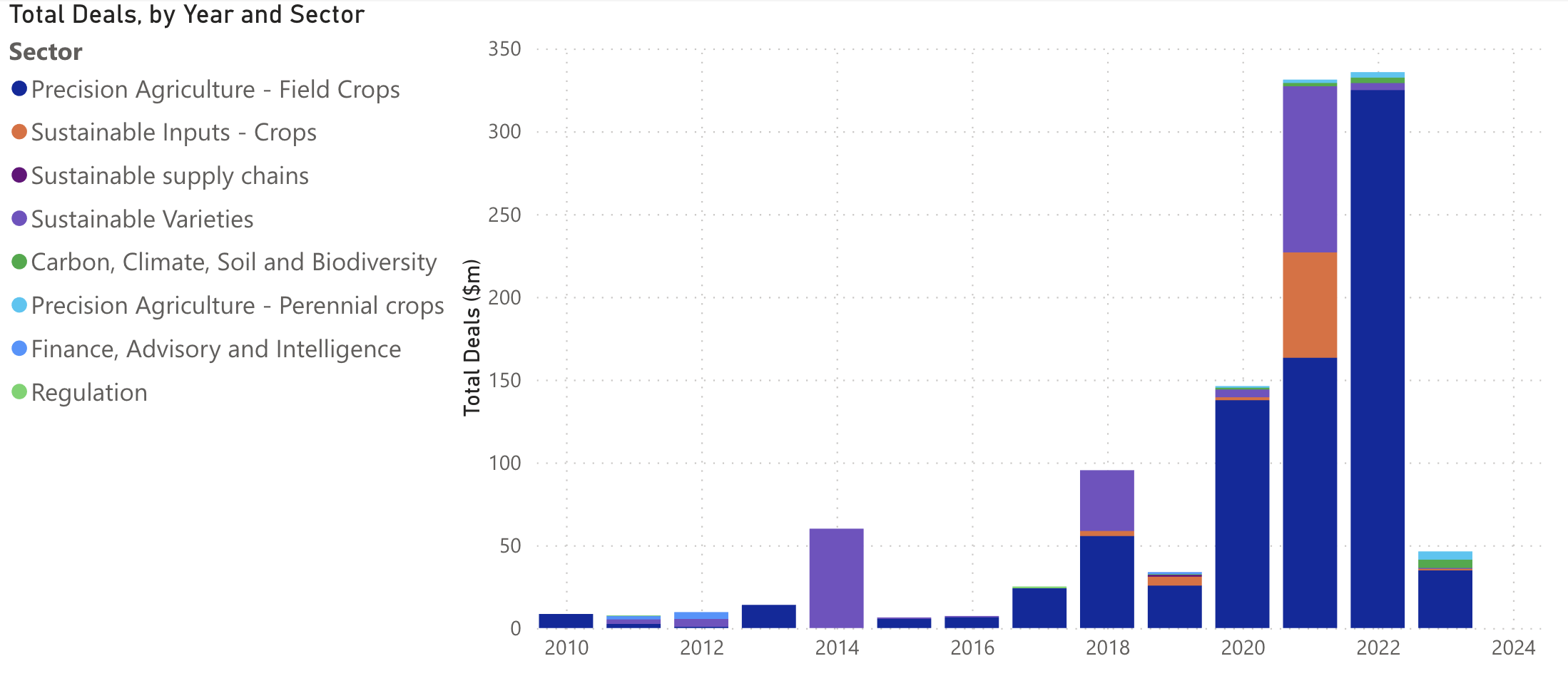Can agricultural technology keep pace with climate change?
Top 10 cleantech agri-food fund-raisings, 2023

Agricultural technology companies are racing to help food producers keep pace with climate change, using tools and technologies, ranging from remote sensing, to crop gene editing, and AI-backed smart irrigation.
Climate change poses a threat to food and farming, as a result of more frequent weather extremes, where floods can halt cultivation, while droughts and heatwaves cut yields, and disruption of the seasons can spread disease.
For example, the European Environment Agency this week reported that Europe is the fastest warming continent in the world, posing climate risks for energy and food security, for ecosystems, infrastructure, water resources and financial stability, as well as for people’s health.
At New Food Finance, we have developed a database of the agtech and foodtech companies that are leading an environmental transition in food production, from reducing biodiversity loss, to cutting greenhouse gas emissions and water pollution, to increasing resilience to climate change.
Climate resilience is a complex field, cutting across highly specific technologies, such as the use of gene editing to develop drought and heatwave resistant crops, to more general themes, which will rise in demand, such as the use of smart irrigation, or the application of so-called regenerative practices which can boost soil health and drought resistance.
To develop a “climate resilience” company list, we combined three core groups. First, we took “pure play” seed producers that specifically refer to the developing of crop varieties that are more resistant to weather extremes. Second, we added companies that reference “climate adaptation” in their core mission, as fundamental to their product, technology or service. And third, we took irrigation specialists that reference the use of AI, ML or alogrithms, to capture companies especially targeting lower water use.
The chart above combines these three groups, showing annual debt and equity investment over time. As can be seen, this is a big growth theme.
Our three climate resilient groups break down as follows:
First, the “extreme weather” crop breeders. These comprised 11 companies that have raised $245 million to date, across 38 individual fund-raising rounds.
One company in this category is Performance Plants, which says it focuses on achieving proven climate resilience, for higher and more consistent crop yields, including heat and drought tolerance, by using advanced genetic and molecular tools to determine the genes responsible for this higher performance.
Second, the “climate adaptation mission” group comprised 19 companies that have raised $821 million, across 71 fund-raisings.
As would be expected from a keyword search approach, these companies covered a spectrum of technologies. Business models included advisory or finance to support regenerative and climate-smart farming practices; precision ag companies using remote sensing to develop predictive models focused on catastrophic floods and droughts; and think-tanks researching climate resilience.
One typical company in this group is Big Terra, which says it uses a combination of satellite observation, and climate, weather and predictive crop modelling, to highlight climate adaptation risks. Another is ADAPTA, which says it works with public, private and financial institutions, to design and implement climate resilience solutions for agricultural value chains, including both large and small farmers, for example to implement regen ag.
Our third group is AI-supported irrigation specialists. These comprised 11 companies that have raised $171 million across 50 fund-raisings.
A typical company here is Spherag, which says it uses internet of things (IoT) devices measuring water pressure and flow, as well as in-field soil moisture, temperature and humidity, to automate control valves, and implement algorithm-supported irrigation schedules.
At New Food Finance, we aim to take discussion of the environmental problems facing food and agriculture sector, and zero in on the opportunities and solutions for a more sustainable food system.
These environmental challenges, and associated opportunities, include –
* biodiversity loss, where solutions include: alternative protein; sustainable supply chains; sustainable outdoor food production (including organic food); carbon, climate and soil MRV; integrated pest management; and sustainable inputs (including biological pesticides)
* water pollution, where solutions include: sustainable inputs for crops (including biostimulants and sustainable chemical fertilisers); and agricultural waste mitigation
* greenhouse gas emissions, where solutions include: methane mitigation (using livestock feeds and methane-eating microbes); alternative proteins; sustainable inputs (including less carbon-emitting biocontrols); and carbon MRV (for soil and other sequestration)
* climate resilience, where solutions include: sustainable varieties (including climate resilient crops), and sustainable food production (including regenerative agriculture and agroforestry)
